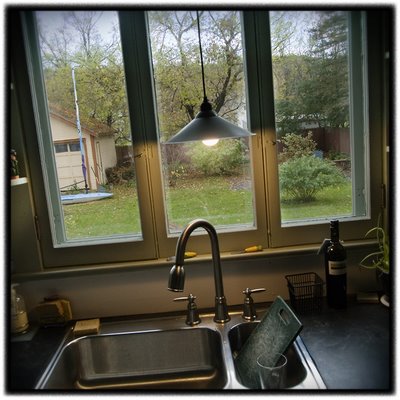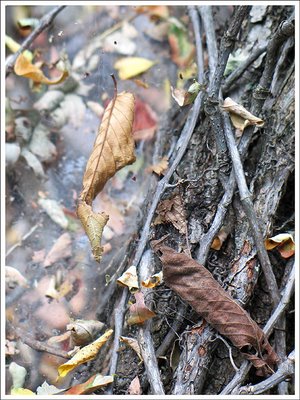ku # 421 and a commentary for your consideration

A between moment - it was very overcast. The light was fading fast and this tree was incredibly intriguing/beckoning.
So I was rummaging around googleworld looking to find commentary on Roland Barthes (1915- 1980) - the French literary critic. He wrote an oft-mentioned (at least in effete/commie-pinko/liberal/pointy-headed intellectual academic circles) book - Camera Lucida. I have read only excerpts from the book, but I have been interested in his notions of studium and punctum.
The following is from an essay - not his book - about those notions (italic emphasis is mine)
For spectators (the viewers of the photographs), Barthes explains that there are two elements involved when viewing a photograph. One element is the studium. The studium is a "kind of education (civility, politeness) that allows discovery of the operator." It is the order of liking, not loving. News photographs are often simple banal, unary photos which exemplify studium because "I glance through them, I don't recall them; no detail ever interrupts my reading: I am interested in them (as I am interested in the world), I do not love them."
The second and far more interesting element for the spectator is punctum. There are two kinds of punctum. The first is that which is "that accident which pricks, bruises me." It is the unintentional detail that could not not be taken, and that "fills the whole picture." Barthes says there is no rule that can be applied to the existence of studium and punctum within a photo except that "it is a matter of co-presence." These are the photos which take our breath away for some reason that was completely unintended by the photographer (or by the subject, for that matter). It is at the moment when the punctum strikes that the photograph will "annihilate itself as medium to be no longer a sign but the thing itself." And the object will become subject again.
Sometimes, the punctum reveals itself after the fact, as a function of memory(attn: JimJ, TomG, MichelleP). It is a testament to the pensiveness of a photograph, comprising the part of the photo that is it at its strongest when one is not looking at the photograph. This pensiveness is the strength of a photograph. The pensiveness is, again, a political element of photography. While most photographs offer only the identity of an object, those that project a punctum potentially offer the truth of the subject. They offer "the impossible science of the unique being."
The second kind of punctum is that of Time. The punctum of time, the existence of the dead with the photographed object, forces the photograph into an unreality, a hallucination of sorts: "on the one hand, it is not there, on the other, it has indeed been." It is the paradox that the object must have existed, and yet at the same time, it cannot be there now. The photograph is "false on the level of perception, true on the level of time." When Barthes is struck by a punctum, he "passed beyond the unreality of the thing represented, I entered crazily into the spectacle, into the image, taking into my arms what is dead, what is going to die." It is, he says, madness. Society wants to tame this madness by making photography an art (Barthes says that no art is mad) or by taming it through generalizing, banalizing it "until it is no longer confronted by any image in relation to which it can mark itself." When the image is stripped of its personal, private reading, the potential for madness is gone. When the image is meant to be viewed when flipping through a magazine, it is inert. Society consumes images now instead of beliefs, in order to keep them from reaching madness.
Think about it and please let me know what you think
FEATURED COMMENT: Ana wrote "So much of the resonance of a photograph is that collision of past, present and future, and existence."










